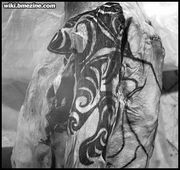Pazyryk Mummies
Between 1929 and 1949, and 1990 and 1995, excavations in the Altai region of Siberia uncovered a number of graves. These burials lent their name to the region, Pazyryk, after the local word for 'burial mound'. Dating to around 400BC, they contained extensive grave goods and several bodies, which were superbly preserved as a result of deliberate embalming and having lain in the frozen ground for almost 2500 years.
Two of these bodies, a male and a female, are tattooed. The vivid blue tattoos are well-executed and extremely detailed, showing various animals and mythical creatures. The depth of skin into which the ink was placed suggests that a skin-pricking method was used to create them, as opposed to the sewing-in of patterns which was customary among the Inuit and various Siberian tribes. The tattoos are located on the shoulders, arms, and legs of the mummies. It is not fully understood whether they served a purely decorative purpose, a magical/protective one, or both.
The Pazyryk were closely related to the Scythian people.
The tattoos in these pictures were discovered by the Hermitage Museum in St. Petersburg, Russia using infrared photography, which later showed that many ancient mummies were extensively tattooed. From a historical point of view, one could make the argument that the periods of Western culture in which tattooing is rare are the unusual periods, rather than the other way around!




